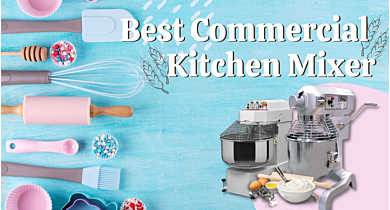If you’re preparing your kitchen, whether it’s a home setup or a commercial space, choosing the right appliances can make all the difference. Two appliances causing a lot of head-scratching lately are the food processor and the blender. Both get the job done, but in very different ways.
So which one belongs on your countertop? This guide is for Canadian kitchens in 2025 and cuts through the noise to help you decide which fits your cooking style, budget, and kitchen space. Plus, you’ll find direct links to browse Zanduco’s top commercial food processors, blenders, and combo appliances.
Food Processor vs Blender - Quick Feature Comparison
| Feature | Food Processor | Blender |
|---|---|---|
| Main Ability | Chop, slice, shred, knead dough | Blend, puree, crush ice, liquefy |
| Container Type | Wide bowl, interchangeable blades | Tall jar with fixed blades |
| Motor Power Range | 400–1200 watts | 1000–1500 watts or more |
| Ideal for | Chunky textures, dough, prep-heavy | Smooth drinks, purees, soups, frozen treats |
| Brands at Zanduco | Robot Coupe, Breville | Vitamix, Ninja |
When Should You Reach for a Food Processor?
Think of a food processor as your sous-chef for the heavy lifting in the kitchen. If you’re chopping up vegetables for a big family dinner, shredding cheese for your poutine, or even kneading dough for fresh bannock, this is your go-to. It’s great at handling lots of different jobs from slicing veggies to mixing a batter, saving you from doing it all by hand.
And if you’re running a café or small restaurant, a solid food processor like the ones you'll find from Robot Coupe on Zanduco can seriously speed up your prep without sacrificing quality. These machines don’t just make the job easier, they help you get more done in less time.
When Does a Blender Make More Sense?
If your kitchen sees a lot of smoothies, soups, or creamy sauces, a blender is probably your best friend. It’s built to pulverize things completely smooth, think silky green smoothies and creamy tomato soup without lumps. And yes, it can crush ice too if you want those cool summer drinks.
Blenders like the Vitamix models from Zanduco bring serious power to the table. They’re also super quick to clean; just rinse and you’re done. Perfect for busy mornings or when you’re making drinks all day long.
What About Those Combo Machines?
If your kitchen counter space is limited or you want one machine that does a bit of everything, combo food processor/blender sets might catch your eye. They’re handy and flexible, but keep in mind they can’t always match the muscle or capacity of a dedicated food processor or commercial blender.
These are great for smaller kitchens or anyone still figuring out which tool fits best.
Tips When You’re Shopping in Canada
Here’s the real talk: don’t just grab the fanciest machine on the shelf. Power is important if you’re chopping or blending a lot, aim for something with enough muscle (usually 700 watts or more). Also, think about how much food you usually make, don’t buy a huge processor if you’re only cooking for yourself.
Zanduco’s got your back with solid warranties and Canadian customer support, which means if anything goes off-script, they’ll help you out without hassle. Plus, they often have good deals and financing options if you want to spread out the cost.
Quick FAQs
What’s the difference between a food processor and a blender?
Think of a food processor as your prep assistant. It slices, chops, shreds, and even kneads dough. A blender, on the other hand, is all about liquids like smoothies, soups, or sauces, anything you want completely silky.
Can a food processor replace a blender?
Sometimes. A food processor can blend ingredients together, but it won’t give you the ultra-smooth texture a blender does. For creamy soups or smoothie-bar results, stick with a blender.
Which one is easier to clean?
Blenders usually come out ahead. Most have just a jar and a blade, so cleanup is quick. Food processors have more parts such as lids, bowls, and blades, which means a bit more time at the sink.
What do professional chefs use?
Both. Chefs reach for a food processor when chopping or shredding in bulk, then switch to a blender for purees, sauces, or anything that needs a smooth finish.
What size should I get for home use in Canada?
For most families, a food processor with a 3–5 liter bowl and a blender with a 1.5–2 liter jar are just right. The bigger the batch, the larger the appliance you’ll want.
Are there appliances that do both jobs?
Yes, there are combo models that try to be both a food processor and a blender. They’re handy if you’re short on space but might not be as good as having each appliance on its own.
Where can I buy good-quality appliances in Canada?
Check out Zanduco.ca. They carry brands like Robot Coupe, Vitamix, Breville, and Ninja, plus they offer Canadian customer support and warranties.





